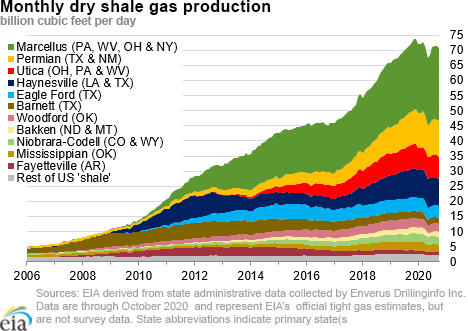In the News:
Lower 48 states working natural gas in underground storage inventories at the end of the refill season (April 1–October 31)
Working natural gas in storage in the Lower 48 states as of October 31 totaled 3,920 billion cubic feet (Bcf), according to interpolated data from EIA’s Weekly Natural Gas Storage Report released November 13. This is the third-highest end-of-refill-season level ever recorded and the highest since 2016, when working natural gas stocks reached 3,977 Bcf. Total inventory as of October 31 was 201 Bcf (5%) higher than the five-year (2014–18) end-of-October average and 194 Bcf (5%) higher than last year at this time.
EIA estimates that net injections totaled 1,914 Bcf during the 2020 refill season (April 1–October 31). Net injections were 94 Bcf (6%) less than the five-year average and 657 Bcf (26%) less than the near-record net injections reported for the 2019 refill season. Working natural gas stocks entered the refill season at 2,006 Bcf this year, following a relatively mild heating season contributing to the smallest net withdrawals since 2016. Because the refill season started above 2,000 Bcf for the third time since 2016, smaller net injections were necessary to reach end-of-refill-season inventory targets.
Declines in natural gas production account for most of the reduction in net injections during the 2020 refill season. Dry natural gas production averaged 88.5 Bcf/day during the 2020 refill season compared with 92.4 Bcf/day during the 2019 refill season, according to IHS Markit. Natural gas consumption during the 2020 refill season was roughly comparable with consumption during the 2019 refill season, with increases in residential and commercial consumption, LNG feedstock, and pipeline exports, slightly exceeding decreases in natural gas consumed for electricity generation, according to IHS Markit.
Although the end of the natural gas storage injection season is traditionally defined as October 31, injections often occur in November. The highest working natural gas level ever recorded occurred during the week ending November 11, 2016, when working natural gas levels totaled 4,047 Bcf.
Overview:
(For the week ending Wednesday, November 18, 2020)
- Natural gas spot prices fell at most locations this report week (Wednesday, November 11 to Wednesday, November 18). The Henry Hub spot price fell from $2.77 per million British thermal units (MMBtu) last Wednesday to $2.36/MMBtu yesterday.
- At the New York Mercantile Exchange (NYMEX), the price of the December 2020 contract decreased 32¢, from $3.031/MMBtu last Wednesday to $2.712/MMBtu yesterday. The price of the 12-month strip averaging December 2020 through November 2021 futures contracts declined 21¢/MMBtu to $2.779/MMBtu.
- The net injections to working gas totaled 31 billion cubic feet (Bcf) for the week ending November 13. Working natural gas stocks totaled 3,958 Bcf, which is 8% more than the year-ago level and 6% more than the five-year (2015–19) average for this week.
- The natural gas plant liquids composite price at Mont Belvieu, Texas, remained flat at $5.38/MMBtu. The price of propane fell by 1%. The price of isobutane rose by 2%. The price of natural gasoline, ethane, and butane remained flat week over week.
- According to Baker Hughes, for the week ending Tuesday, November 10, the natural gas rig count increased by 2 to 73. The number of oil-directed rigs rose by 10 to 236. The total rig count increased by 12, and it now stands at 312.
Prices/Supply/Demand:
Prices are down in most locations outside of the Northeast. This report week (Wednesday, November 11 to Wednesday, November 18), the Henry Hub spot price fell 41¢ from $2.77/MMBtu last Wednesday to a low of $2.36/MMBtu yesterday. Temperatures were generally warmer than normal across most of the Lower 48 states and colder than normal across the Great Lakes region. At the Chicago Citygate, the price decreased 50¢ from $2.58/MMBtu last Wednesday to a low of $2.08/MMBtu yesterday. The price at PG&E Citygate in Northern California fell 17¢, down from $3.89/MMBtu last Wednesday to $3.72/MMBtu yesterday. The price at SoCal Citygate in Southern California decreased 28¢ from a high of $4.27/MMBtu last Wednesday to $3.99/MMBtu yesterday.
Northeast prices rise in demand centers, fall in production areas. At the Algonquin Citygate, which serves Boston-area consumers, the price went up 64¢ from a low of $1.58/MMBtu last Wednesday to $2.22/MMBtu yesterday after reaching a high of $4.36/MMBtu on Tuesday because of cold temperatures. At the Transcontinental Pipeline Zone 6 trading point for New York City, the price increased 22¢ from a low of $1.48/MMBtu last Wednesday to $1.70/MMBtu yesterday.
The Tennessee Zone 4 Marcellus spot price decreased 27¢ from $1.36/MMBtu last Wednesday to $1.09/MMBtu yesterday. The price at Dominion South in southwest Pennsylvania fell 26¢ from $1.38/MMBtu last Wednesday to $1.12/MMBtu yesterday.
Permian Basin prices fall, widening discount to the Henry Hub. The price at the Waha Hub in West Texas, which is located near Permian Basin production activities, averaged $2.49/MMBtu last Wednesday, 28¢/MMBtu lower than the Henry Hub price. Yesterday, the price at the Waha Hub averaged a low of $1.08/MMBtu, which was $1.28/MMBtu lower than the Henry Hub price. The decline in the price at the Waha Hub occurred in conjunction with a force majeure on the Natural Gas Pipeline Company of America (NGPL) pipeline which limited delivery to Sabine Pass from the Permian Basin—and several maintenance projects on the El Paso Natural Gas pipeline, according to S&P Platts.
Supply rises. According to data from IHS Markit, the average total supply of natural gas rose by 4.2% compared with the previous report week. Dry natural gas production grew by 2.5% compared with the previous report week and reached a high of 91.6 Bcf/d on November 18, the highest level of production since April. Average net imports from Canada increased by 47.8% from last week, with higher imports at border crossing points in the Midwest, according to Genscape.
Demand rises because of heating demand in buildings. Total U.S. consumption of natural gas rose by 22.8% compared with the previous report week, according to data from IHS Markit. Natural gas consumed for power generation rose by 2.6% week over week. In the residential and commercial sectors, consumption climbed by 81.9% with temperatures across the Lower 48 states generally averaging between 40 and 60 degrees Fahrenheit. Industrial sector consumption increased by 5.8% week over week. Natural gas exports to Mexico increased 1.1%. Natural gas deliveries to U.S. liquefied natural gas (LNG) export facilities (LNG pipeline receipts) averaged 10.2 Bcf/d, or 0.06 Bcf/d lower than last week.
U.S. LNG exports are flat week over week. Eighteen LNG vessels (seven from Sabine Pass, four from Cameron, three each from Corpus Christi and Freeport, and one from Cove Point) with a combined LNG-carrying capacity of 64 Bcf departed the United States between November 12 and November 18, 2020, according to shipping data provided by Bloomberg Finance, L.P. Two more tankers were loading on Wednesday, November 18—one at Freeport LNG terminal and one at Corpus Christi LNG.
Storage:
The net injections into storage totaled 31 Bcf for the week ending November 13, compared with the five-year (2015–19) average net withdrawals of 24 Bcf and last year's net withdrawals of 66 Bcf during the same week. Working natural gas stocks totaled 3,958 Bcf, which is 231 Bcf more than the five-year average and 293 Bcf more than last year at this time.
According to The Desk survey of natural gas analysts, estimates of the weekly net change to working natural gas stocks ranged from net withdrawals of 19 Bcf to net injections of 41 Bcf, with a median estimate of net injections of 21 Bcf.
More storage data and analysis can be found on the Natural Gas Storage Dashboard and the Weekly Natural Gas Storage Report.
See also:
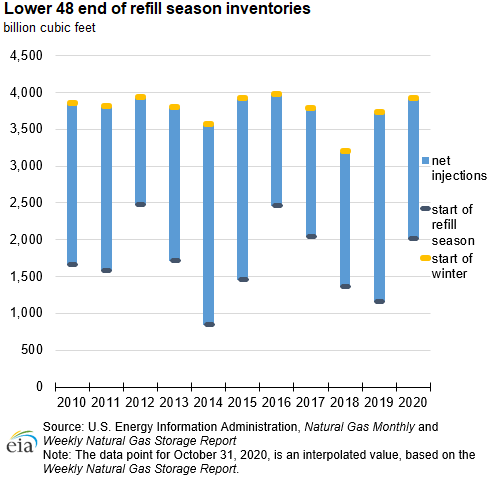
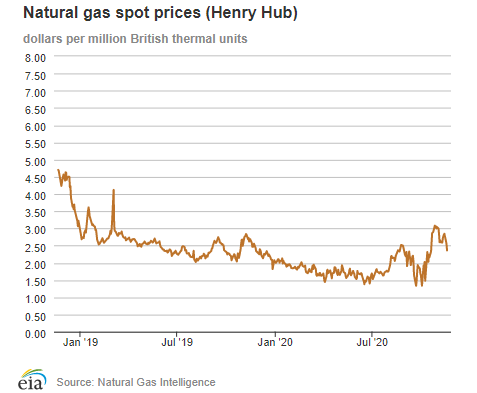
| Spot Prices ($/MMBtu) | Thu, 12-Nov |
Fri, 13-Nov |
Mon, 16-Nov |
Tue, 17-Nov |
Wed, 18-Nov |
|---|---|---|---|---|---|
| Henry Hub |
2.82 |
2.85 |
2.63 |
2.54 |
2.36 |
| New York |
1.90 |
1.64 |
2.45 |
2.50 |
1.70 |
| Chicago |
2.69 |
2.68 |
2.45 |
2.32 |
2.08 |
| Cal. Comp. Avg.* |
3.37 |
3.34 |
3.17 |
3.10 |
3.16 |
| Futures ($/MMBtu) | |||||
| December contract | 2.976 |
2.995 |
2.697 |
2.692 |
2.712 |
| January contract |
3.094 |
3.122 |
2.864 |
2.844 |
2.838 |
| *Avg. of NGI's reported prices for: Malin, PG&E Citygate, and Southern California Border Avg. | |||||
| Source: NGI's Daily Gas Price Index | |||||
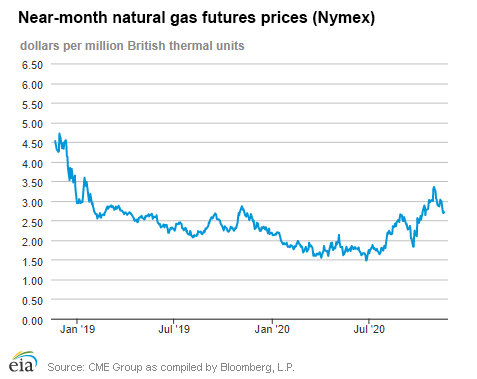
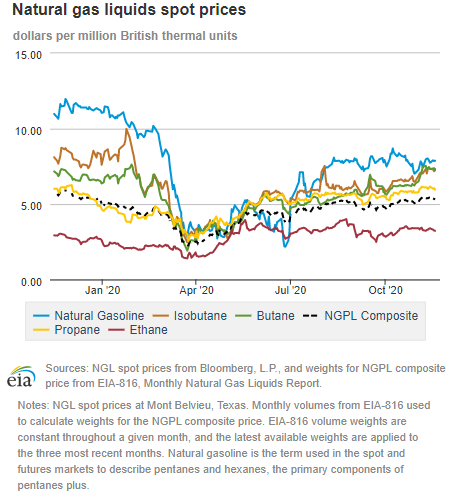
| U.S. natural gas supply - Gas Week: (11/12/20 - 11/18/20) | |||
|---|---|---|---|
Average daily values (Bcf/d): |
|||
this week |
last week |
last year |
|
| Marketed production | 101.9 |
99.7 |
107.3 |
| Dry production | 90.6 |
88.4 |
95.4 |
| Net Canada imports | 5.0 |
3.4 |
5.0 |
| LNG pipeline deliveries | 0.1 |
0.1 |
0.2 |
| Total supply | 95.8 |
91.9 |
100.7 |
|
Source: IHS Markit | |||
| U.S. natural gas consumption - Gas Week: (11/12/20 - 11/18/20) | |||
|---|---|---|---|
Average daily values (Bcf/d): |
|||
this week |
last week |
last year |
|
| U.S. consumption | 75.6 |
61.5 |
90.7 |
| Power | 25.5 |
24.8 |
29.5 |
| Industrial | 23.2 |
21.9 |
24.0 |
| Residential/commercial | 27.0 |
14.8 |
37.3 |
| Mexico exports | 5.5 |
5.4 |
5.4 |
| Pipeline fuel use/losses | 7.1 |
6.6 |
7.8 |
| LNG pipeline receipts | 10.2 |
10.2 |
7.1 |
| Total demand | 98.3 |
83.8 |
111.0 |
|
Source: IHS Markit | |||
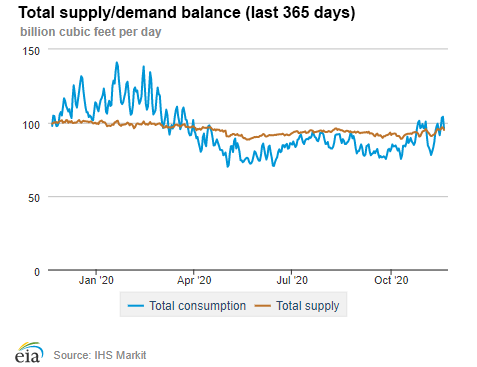
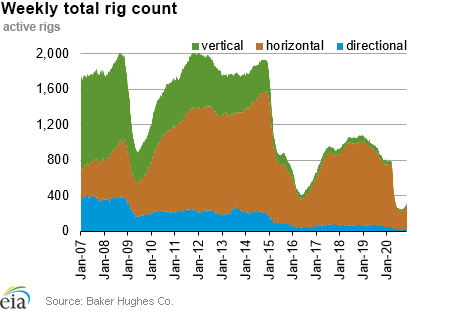
| Rigs | |||
|---|---|---|---|
Tue, November 10, 2020 |
Change from |
||
last week |
last year |
||
| Oil rigs | 236 |
4.4% |
-65.0% |
| Natural gas rigs | 73 |
2.8% |
-43.4% |
| Note: Excludes any miscellaneous rigs | |||
| Rig numbers by type | |||
|---|---|---|---|
Tue, November 10, 2020 |
Change from |
||
last week |
last year |
||
| Vertical | 22 |
0.0% |
-56.0% |
| Horizontal | 267 |
3.1% |
-62.0% |
| Directional | 23 |
21.1% |
-57.4% |
| Source: Baker Hughes Co. | |||
| Working gas in underground storage | ||||
|---|---|---|---|---|
Stocks billion cubic feet (Bcf) |
||||
| Region | 2020-11-13 |
2020-11-06 |
change |
|
| East | 953 |
942 |
11 |
|
| Midwest | 1,139 |
1,127 |
12 |
|
| Mountain | 241 |
243 |
-2 |
|
| Pacific | 319 |
322 |
-3 |
|
| South Central | 1,306 |
1,293 |
13 |
|
| Total | 3,958 |
3,927 |
31 |
|
|
Source: Form EIA-912, Weekly Underground Natural Gas Storage Report | ||||
| Working gas in underground storage | |||||
|---|---|---|---|---|---|
Historical comparisons |
|||||
Year ago (11/13/19) |
5-year average (2015-2019) |
||||
| Region | Stocks (Bcf) |
% change |
Stocks (Bcf) |
% change |
|
| East | 916 |
4.0 |
902 |
5.7 |
|
| Midwest | 1,080 |
5.5 |
1,086 |
4.9 |
|
| Mountain | 206 |
17.0 |
215 |
12.1 |
|
| Pacific | 291 |
9.6 |
315 |
1.3 |
|
| South Central | 1,173 |
11.3 |
1,208 |
8.1 |
|
| Total | 3,665 |
8.0 |
3,727 |
6.2 |
|
| Source: Form EIA-912, Weekly Underground Natural Gas Storage Report | |||||
| Temperature – heating & cooling degree days (week ending Nov 12) | ||||||||
|---|---|---|---|---|---|---|---|---|
HDD deviation from: |
CDD deviation from: |
|||||||
| Region | HDD Current |
normal |
last year |
CDD Current |
normal |
last year |
||
| New England | 50 |
-99 |
-155 |
0 |
0 |
0 |
||
| Middle Atlantic | 48 |
-92 |
-151 |
0 |
0 |
0 |
||
| E N Central | 69 |
-89 |
-186 |
1 |
1 |
1 |
||
| W N Central | 108 |
-66 |
-158 |
0 |
0 |
0 |
||
| South Atlantic | 23 |
-68 |
-108 |
35 |
20 |
19 |
||
| E S Central | 29 |
-64 |
-129 |
10 |
8 |
10 |
||
| W S Central | 20 |
-38 |
-92 |
29 |
20 |
26 |
||
| Mountain | 163 |
7 |
28 |
3 |
1 |
-3 |
||
| Pacific | 118 |
43 |
88 |
0 |
-1 |
0 |
||
| United States | 73 |
-49 |
-94 |
11 |
7 |
7 |
||
|
Note: HDD = heating degree day; CDD = cooling degree day Source: National Oceanic and Atmospheric Administration | ||||||||
Average temperature (°F)
7-day mean ending Nov 12, 2020
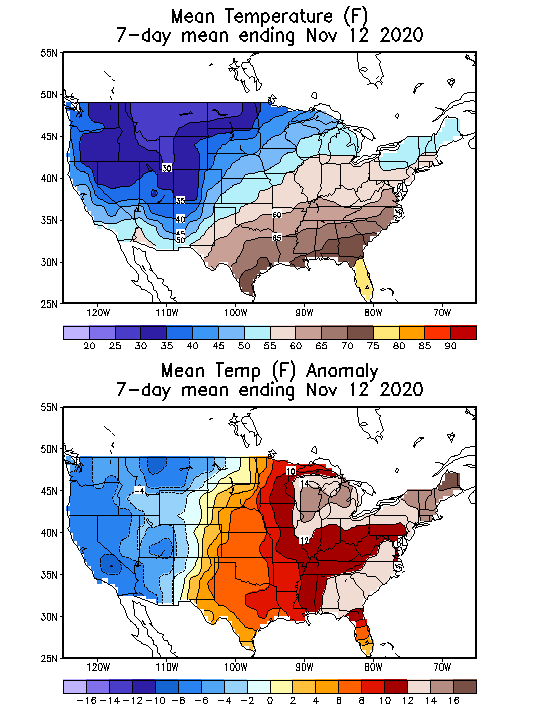
Source: National Oceanic and Atmospheric Administration
Deviation between average and normal (°F)
7-day mean ending Nov 12, 2020

Source: National Oceanic and Atmospheric Administration

